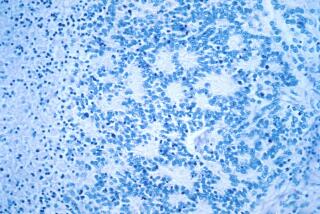HIV-resistant cells work in mice. Can they help humans?
Clad in a yellow gown, blue foot covers, hair net, face mask and latex gloves, Paula Cannon pushed open the door to the animal room. “I hate this smell,” she said, wrinkling her nose.
The stink came from scores of little white mice scurrying about in cages. Some of the cages were marked with red biohazard signs, indicating mice that had been injected with HIV.
Yet, in some of the animals — ones with a small genetic change — the virus never took hold.
Like mouse, like man? Maybe so.
In early 2007, a patient in Berlin needed a bone marrow transplant to treat his leukemia. He was also HIV positive, and his doctor had an idea: Why not use the marrow from one of the rare individuals who are naturally resistant to HIV and try to eradicate both diseases at once?
It worked. Sixty-one days after the patient’s transplant, his virus levels were undetectable, and they’ve stayed that way.
Since news of the man’s cure broke, HIV patients have been telephoning doctors to ask for bone marrow transplants. But it’s not that simple. The treatment is too risky and impractical for widespread use.
“A bone marrow transplant — it’s a horrible process you would not wish on your worst enemy unless they needed one to save their life,” said Cannon, a biology professor at USC’s Keck School of Medicine. There are grueling treatments to prepare a patient for transplant; the danger of rejecting the marrow; and the risk of graft-versus-host disease, wherein the marrow attacks the patient.
And that’s assuming the patient can find a matching donor — a difficult proposition in itself — with the right HIV-resistant genetic constitution, which is present in only about 1% of the Caucasian population.
But there could be another way.
Instead of sifting through the sands for a rare donor and then subjecting a patient to the dangers of a bone marrow transplant, Cannon and her colleague Philip Gregory, chief scientific officer at the Richmond, Calif.-based biotech company Sangamo BioSciences, began to think: They could use gene therapy instead, to tweak a patient’s own cells to resistance — and recovery.
The mouse “cure,” they say, suggests they’re on the right track.
Now, with $14.5 million from the California Institute for Regenerative Medicine, the San Francisco-based stem cell research-funding center created by 2004’s Proposition 71, Cannon, Gregory and researchers at the City of Hope cancer center in Duarte are working toward bringing the technique to clinical trials within four years.
Cannon and other HIV researchers insist that, despite cancers and deaths associated with past gene therapy trials, it’s the right way to target the disease. They cite recent successes, including treatments that cured children with the “bubble boy” syndrome and helped blind children regain their vision.
“I don’t think anyone would want to do gene therapy if there were an alternative,” said Caltech biologist David Baltimore, one of the many L.A.-based researchers pursuing gene therapy strategies to prevent or cure HIV. “I think it’s absolutely necessary. Nothing else will work.”
Since AIDS emerged in the early 1980s, development of anti-HIV medications has turned the disease from a virtual death sentence into a chronic, manageable condition.
But the clamor for a cure hasn’t quieted.
Vaccine trials have failed; drug-resistant strains are on the rise; and the meds, which can have uncomfortable side effects such as fatigue, nausea and redistribution of body fat that creates a so-called buffalo hump, cost about $20,000 a year.
A bone marrow transplant is about five times as expensive, but it would have to be done only once.
The question was, could researchers create bone marrow stem cells that — just like the marrow the Berlin patient received — lack the crucial gene, CCR5, that normally lets HIV into the key immune cells it destroys?
In 2006, Gregory asked Cannon if she was interested in testing whether a tool his company developed, called a zinc finger nuclease, could do the trick.
Zinc finger nucleases are genetic scissors, cutting DNA at a specific site — say, in the middle of the CCR5 gene. When the cell glues the gene back together, it usually makes a mistake, resulting in a gene that no longer works.
“It just jumped out at me as, ‘Oh my gosh, that’s actually something that could work,’ ” Cannon said.
The team spent about a year optimizing the procedure for treating delicate stem cells with the CCR5 snippers.
They tested the method using so-called humanized mice — ones engineered to have a human immune system — because HIV doesn’t infect normal mice. When stem cells were treated with the molecular scissors before being injected into mice, the resulting immune system lacked CCR5, exactly as the scientists had hoped.
These mice acted just like the Berlin patient — they fought off the virus.
Ready to make the leap from mouse to man, Gregory found a third leg for the team: researchers at City of Hope, who had extensive bone marrow transplant expertise.
“They brought Paula’s data to us and we said, ‘Wow, this looks fantastic,’” said Dr. John Zaia, City of Hope’s deputy director for clinical research.
Researchers there are now working toward clinical trials, optimizing every element of the treatment for safety, effectiveness and reproducibility.
On a wiltingly hot afternoon in July, lab manager Lucy Brown maneuvered a computer mouse across three screens speckled with red, yellow and green dots.
The computer was hooked to a flow cytometer — a collection of black boxes, green wires and silver knobs that can detect subtle differences between cells and separate them at a rate of 50,000 per second. This is how the scientists will separate stem cells from patients’ blood once trials are underway, to be sure that the genetic fix in the CCR5 gene was made, and kept.
Upstairs, machines with mazes of sterile tubes and pumps stood ready to prepare cells for CCR5-snipping. Here, the scientists will purify the bone marrow stem cells, increasing their numbers first to 5% of total cells, up from a measly 0.1% in the starting mixture, and then to 99%. At this point they can begin testing methods to clip the cells’ DNA.
When all is perfected, the scientists will have a precise recipe for producing batches of engineered stem cells, including exactly how long the cells should be treated, how much of each chemical needs to be added, how pure the cells need to be, and thousands of other details.
“We are literally writing the book on how you do this,” said David DiGiusto, director of City of Hope’s bone marrow stem cell therapy research.
To receive FDA approval for clinical trials — a goal they hope to achieve in three to four years — the researchers must prove that they can safely and reliably prepare the cells. Once they get the green light, the first cases will probably be people like the Berlin patient who need bone marrow transplants to treat AIDS-related lymphoma.
They’ll modify the patients’ cells in the stringently sterile manufacturing lab that DiGiusto designed with details such as cove molding and seamless floors so there are no corners or cracks to collect dust. Anyone who enters must wear a full bunny suit, much like the one Cannon wears in her mouse room, to keep from contaminating the delicate cells.
Some have advertised the effort as a quest for the elusive “C” word, but Cannon doesn’t quite see it that way.
“People say we’re trying to cure HIV,” she said. “I think of it more as, we’re just trying to make the body live quite happily and healthily with a small amount of virus.”
rachel.bernstein@latimes.com






